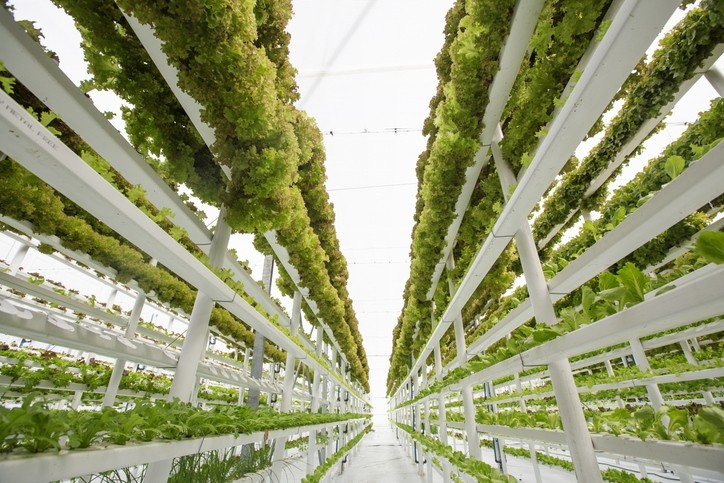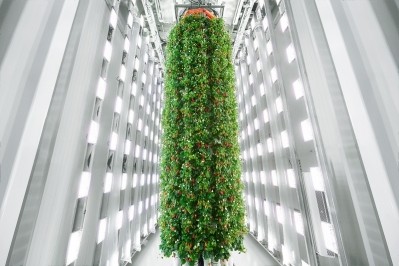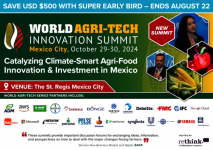Has the environmental case for vertical farming just been stacked up?

The researchers studied Harvest Farm’s production facility in London.
They calculated it produced the equivalent of 740g of CO2 per kilogram of lettuce.
This is comparable to the emissions created when growing lettuce in a field, but the vertical farm used a lot less land in the process.
In vertical farms, shelves of crops like lettuce or herbs are stacked on top of each other in a controlled environment. Plants can grow without soil by being drip-fed with nutrient-rich water or sprayed with mist onto their exposed roots.
At the lettuce farm where the researchers studied, electricity use made up nearly 40% of its total climate change impact. As such, the climate impact of vertical farming depends a lot on how that electricity is generated.
The researchers also studied other environmental impacts like land use, water use, and water pollution.
‘Greener than first thought’
Commenting on the results, co-author of the study and a senior lecturer at the University of Surrey’s Centre for Environment and Sustainability, Dr Zoe M Harris, said that the research was an “important” first step towards demonstrating that vertical farming is “greener than first thought”.
“Our findings show that vertical farms can help reduce the climate impact of farming, especially if their electricity comes from renewable sources,” Dr Harris explained.
“Vertical farming uses about 28 times less land than traditional farming methods. If all lettuce fields were replaced with vertical farms, we could save over 8,000 hectares in the UK alone.
“That could free up land to grow other crops. Vertical farms can also be built in cities, significantly reducing the impact of transporting the crop to the people who eat them.”
Michael Gargaro, a researcher at Surrey’s Centre for Environment and Sustainability, called for further research into the sustainability of the food sector to take place.
“One of the biggest environmental impacts came from the jute plugs the lettuce seeds are grown in,” Gargaro added.
“They made up 18% of the climate change impact, as well as the lion’s share of the water pollution and land use too. Using another material could make a vertical farm even more sustainable. Future research should consider alternatives like coconut fibre, hemp or perlite.”
But is there going to be enough renewable energy to maximise the benefits of vertical farming?
The study is more evidence suggesting vertical farming is a promising technology that could play a crucial role in sustainable agriculture and food production in the future.
But electricity requirements were a primary environmental hotspot, accounting for nearly 40% of the climate change impact from the vertical lettuce farm.
Using renewable energy to power vertical farms could reduce climate change impacts by six-fold, bringing emissions in line with traditional field-based lettuce cultivation.
It begs the question: is there going to be enough renewable energy in the UK to maximize the benefits of vertical farming?
“I can't see that being a problem,” Harvest Farm’s co-founder Matt Chlebek told AgTechNavigator.
While there is significant potential for renewable energy to maximise the benefits of vertical farming, achieving this goal will require continued technological advancements, cost reductions, and strategic implementation.
But renewables are being deployed globally at a rate far greater than expected, Chlebek said, adding that Harvest Farm’s facility is already powered by 100% renewable energy.
“In the UK we're starting to see days where renewable sources are producing so much energy that it's leading to negative energy pricing.”
Renewable energy generation in the UK is now at 39 terawatts which is around three orders of magnitude more than even the biggest vertical farms that are operating today, according to Chlebek.
“As more large-scale vertical farms are built it can only help to decarbonise the grid; these kinds of facilities are steady, reliable consumers of power which is an attractive customer for the people responsible for deploying renewable energy,” he said.
“Large vertical farms can also operate dynamically, allowing them to load-balance the grid during times of higher and lower energy production.
“By working closely with energy suppliers and infrastructure investors, vertical farms can not only be off-takers of this energy but also encourage further renewable energy generation to be built.”





















